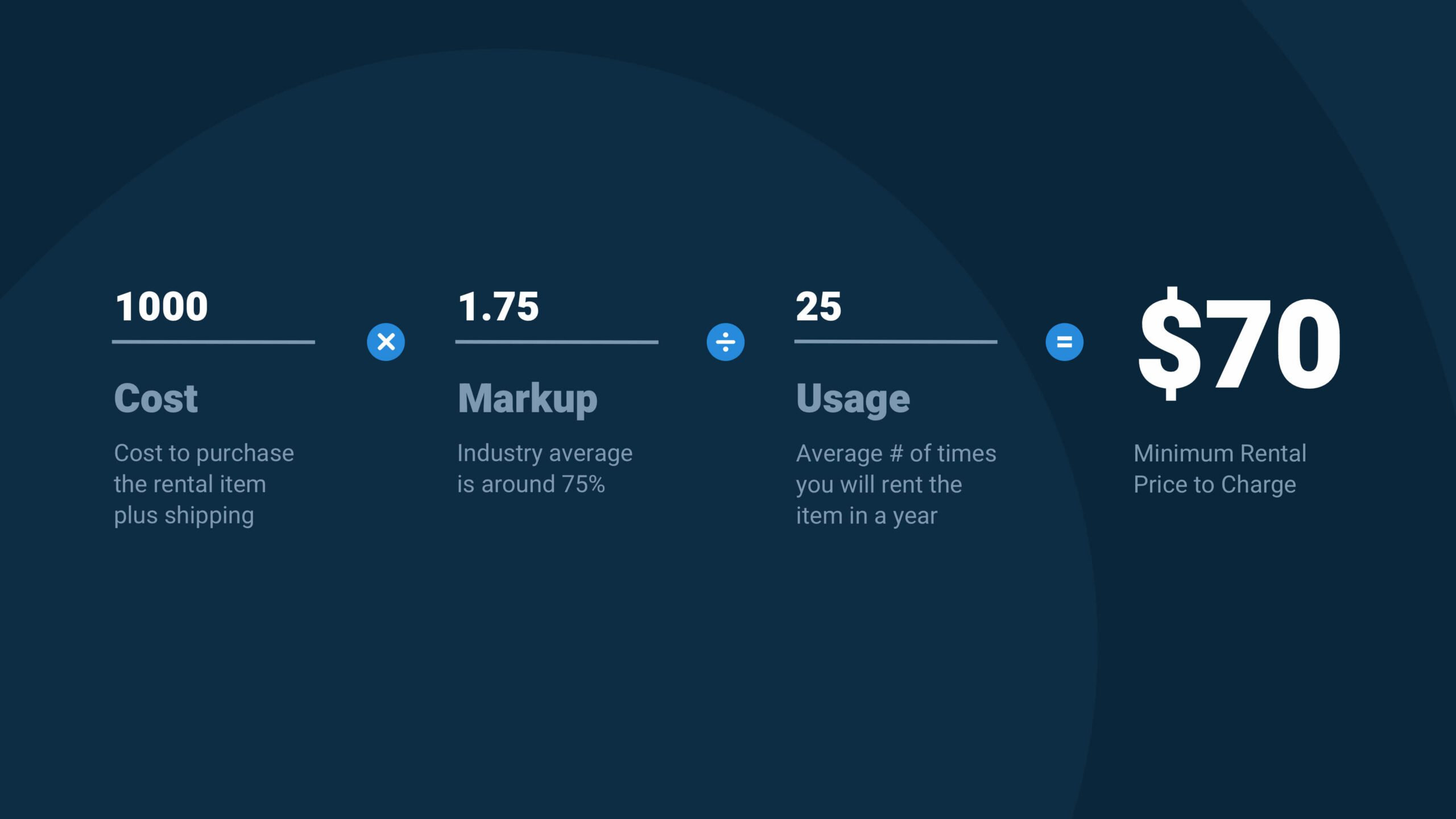
Some of the most common questions when starting a rental business are how to price rental items, or how to calculate equipment rental rates. Whether you have decided to run a party equipment rental business or a tools and equipment rental business, determining your rental rates is probably one of the most challenging parts of getting started.
Why? Because it’s kind of like walking a tightrope. You need to ensure that your rental prices are both competitive and profitable. Maximizing ROI on rental equipment while remaining competitive and affordable is challenging for even the most seasoned rental entrepreneurs!
In this guide, we will provide you with practical tips on how to price rental items. We’ll also explore tools available to business owners that make this process a lot easier!

Types of Equipment and Party Rental Pricing
If you’re wondering how to price rental items, you’re actually considering party and equipment rental rates.
Two common rental pricing strategies used by rental businesses across the industry are flat fees and time-based prices. Each serves a specific purpose, and many rental businesses use them both for different kinds of rentals.
1. Flat Fees: Simple and Transparent
Flat fees, also known as fixed fees or one-time fees, provide customers with a straightforward and transparent price on their order(s). With this approach, businesses charge a fixed price for the use of an item or service for a set time. Flat fees are commonly applied to rental items or services with consistent costs and are typically used for shorter periods.
Advantages:
- Clarity for Customers: Flat fees offer clear and predictable pricing, making it easy for customers to budget and plan their rental expenses.
- Operational Efficiency: Flat fees simplify the rental process and reduce administrative complexities, benefiting both customers and rental businesses.
Example:
An audio-visual equipment rental company may offer flat fees for renting projectors for an event regardless of its duration because it makes a significant portion of its profit from the service of setting up and taking down.
2. Structured Pricing
Structured pricing is a tiered, time-based option whereby the fees gradually decrease for longer rental periods. This approach offers customers flexibility, allowing them to rent items for precisely the time needed. Time-based pricing is commonly used for items rented for more extended periods or when the rental business incurs variable costs based on the rental duration.
Advantages:
- Customizable Rentals: Time-based prices cater to customers’ varying needs, enabling them to rent items for the specific duration required for their events or projects.
- Revenue Optimization: Rental businesses can adjust time-based prices to capitalize on peak demand periods, increasing their revenue potential.
Examples:
A party rental company may offer daily rates for tables and chairs to accommodate multi-day events. The weekly rate may be equal to three days and the monthly rate could be equal to two weeks. The daily rate decreases as the time is extended.
An equipment rental company may charge hourly rates for customers who need power tools for only a few hours or monthly rates for projects that take longer.
What Kinds of Rental Rates are Most Common?
Most rental companies offer a combination of flat fees and structured pricing, tailoring their approach to suit the nature of their inventory and customer preferences.
Considerations such as the type of rental items, market demand, customer preferences, and competitors’ pricing should all play a role in determining the optimal pricing strategy.

How to Do Market Research for Rental Pricing
In the context of a rental business, market research is the process of gathering and analyzing information related to the rental market, customer preferences, and competitor rates.
So, how do you perform market research as a rental business wondering how to set equipment rental rates?
Research Your Competitors
Break out that spyglass because it is time to do some digging! Start with your competitors. Ask yourself these questions:
- Do my competitors offer the same inventory I plan to offer?
- What are my competitors charging for services I plan to provide?
- Are customers happy with my competitors’ prices?
- Are customers happy with my competitors’ services?
- Can I charge what my competitor is charging, or less, and still come out profitable?
The answers to these questions will act as a great starting point as you decide what your rental rates will be. But here’s the thing:
Your competitor is not you.
When you see your competitor’s prices, your knee-jerk reaction may be “Oh my gosh, I have to charge less than this guy, or I won’t be able to compete!” and that simply isn’t true. But if you do plan to, or need to, charge more — you must be able to justify your prices with high-quality rentals and services.
You’ll also need to put in the work to rank above your competitors on Google and secure online traffic using a combination of Google Ads and organic SEO.
Take Advantage of Seasonal Markets When Pricing Rental Items
Whether you’re new to the rental industry or a veteran looking for tips on pricing equipment rental rates, most people know that the party and equipment rental markets are both seasonal.
What does this mean? Certain rental items may be in high demand during holidays, festivals, or weddings. However, you will likely experience lower demand during slow months.
Peak Season Equipment Rental Rates
During peak seasons, when demand for rental items is at its highest, rental companies can, and often do, set higher prices. Customers are often willing to pay a premium to secure the items they need for their special events or projects. If you have limited inventory or availability, this is a great way to curb incoming orders and make more money while doing it.
Another common strategy during peak season is not to increase prices but to increase marketing budgets for Google Ads. Peak season is a great time to capture more orders from party and event planners who are searching for rentals online. This strategy is great for rental businesses with more availability who want to maximize their order intake and conversion.
Off-Peak Season Equipment Rental Rates
Off-peak season is a little more challenging, as there are fewer orders coming in and a lot more competition. This is when it might be a good time to adopt more competitive pricing strategies.
Lower prices can entice customers who are cost-conscious or planning events during less busy times of the year. When you offer attractive rates during off-peak periods, you can increase bookings and revenue during traditionally slower times.
How To Calculate Rental Item Prices
Below is an oversimplified calculator you can use to get started. This will be the minimum daily rental price. Make sure to add in additional costs.
Please keep in mind that the above calculations are simplified and that you should consider your own business goals and needs when considering how to calculate the rental rate for equipment and other types of items.
This calculator is meant to give you a jumping-off point and shows one way that businesses can calculate pricing on an item. You must factor in market research and your company’s positioning strategy. For example, if your company offers white glove service, you should price it at a premium. Or, if your target audience is more price-conscious, you may want to lower the expectations for the service provided.
Want to know how to calculate the ROI on your items? Check out our free ROI calculator here!
Costs to Consider When Calculating Equipment Rental Rates
Initial Investment
Calculating the initial investment in your rental items lays the groundwork for a sustainable pricing strategy that ensures your business’s profitability. This includes the purchase price of the equipment, any associated shipping and handling costs, and any additional fees required for setup or installation.
By understanding the total investment you’ve made in your rental items, you can determine the minimum price point needed to cover these acquisition costs.
Maintenance Costs
You need to consider maintaining your inventory. Keeping your inventory in top-notch shape costs money, especially for the tools and equipment industries. Regular maintenance, routine inspections, and occasional repairs are all part of the ongoing upkeep expenses.
Calculate the annual maintenance and repair costs for each item in your inventory to ensure your pricing remains competitive and sustainable. Incorporate these costs into your pricing structure to ensure you can cover these expenses while providing well-maintained equipment to your customers.
Overhead Costs
Running a successful rental business entails more than just acquiring inventory and setting rental rates. Behind the scenes, there are various “overhead costs” that keep the operations afloat and the business running smoothly. These expenses include rental facility costs, administrative expenses, insurance premiums, marketing efforts, and general operating costs.
From maintaining a well-equipped rental space to ensuring seamless customer interactions, these overhead costs are the backbone of a thriving rental company. Factor in these expenses when calculating rental prices to ensure the pricing strategy remains financially sound, competitive, and sustainable.
Best Practices for Pricing Rental Inventory

Offer Bundling & Discounts
Bundling inventory refers to combining related rental items or services into attractive packages. By bundling complementary items together, rental businesses create compelling offers that cater to various customer needs. Whether it’s a party package that includes tables, chairs, and decorations, or a multimedia bundle comprising projectors, screens, and sound systems, customers are drawn to the convenience and cost-effectiveness of these all-in-one solutions.
Offering discounts based on rental duration, bulk orders, or seasonal promotions encourages customers to choose your rental business over competitors. Whether it’s a percentage off for longer rental periods or special deals during slow seasons, discounts demonstrate your commitment to customer satisfaction while boosting your rental business’s competitiveness.
By combining bundling and strategic discounts, you can create a cutting-edge pricing strategy that caters to diverse customer preferences and fosters loyalty when customers feel like they are getting a good deal.

Gather Feedback from Customers
Before finalizing your rental prices, consider testing different pricing strategies or conducting a pilot run to gather feedback from customers. Monitor the performance of your pricing strategy and be prepared to make adjustments based on customer responses and market trends.
This can be done through surveys, focus groups, or one-on-one interviews. Ask customers about their perception of the pricing, whether they find the rates fair and competitive, and if the value provided meets their expectations.
Customer feedback is invaluable for understanding how the pricing strategy aligns with customer needs and preferences. It can reveal potential pain points, areas for improvement, and opportunities for further customization.

Choose Rental Software Carefully
A great way to maximize your profits and ensure that you are pricing your inventory well is to use a rental software that includes the following:
- Smart reporting features that actually offer insights: A good rental software should provide you with profitability reports as well as payment reports that allow you to gain quick insights into which items are most profitable and who your best customers are.
- Dynamic pricing: Look into rental software that offers dynamic pricing. Dynamic pricing should allow you a bit more flexibility when it comes to pricing your inventory, like customized and automated pricing adjustments, as well as flexible billing periods (calendar, 31-day, and/or 28-day billing cycles).
These features are a great way to stay on top of pricing, and help you ensure that you are getting the most out of your items.
Set Fair and Realistic Profit Margins
While it may be tempting to set rental prices as high or as low as possible, this can alienate price-sensitive customers and negatively impact your business.
Instead, use the data from these cost analyses to set fair and competitive rental rates. Factor in your business goals, target customer base, and desired profit margins to arrive at a pricing structure that ensures customer satisfaction while ensuring your business remains profitable in the long run. It is a good idea to add labor as a separate line item. That way, you can capture price-sensitive customers and offer high-end service to those willing to pay for it.
By understanding the competitive landscape and aligning pricing strategies with customer needs, you can confidently set profit margins that support business growth and provide value to your customers.
Other blogs you may find helpful:
How to Increase Profit Margins for Rental Businesses
Frequently Asked Questions
You can use a rental calculator to get started, but you need to consider initial investment, maintenance costs, overhead costs, and competitor pricing. There are some general rules of thumb, but simply marking it up based on a percentage of retail cost is too simplistic and your profits will suffer as a result.
Cost of equipment equals initial investment + shipping. Before setting a rental price, you need also factor in overhead cost and competitor pricing.
Rental businesses have about a 50% profit margin with net profits averaging around 15%. Of course this is dependent upon the specific types of rentals and size of the business. Pricing the rentals correctly and making sure you account for labor involved can make a big difference towards your bottom line.
